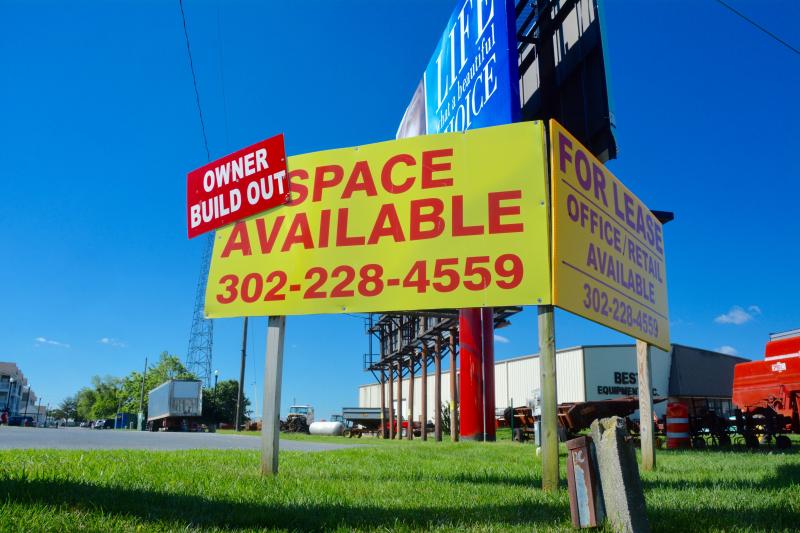The placement of billboards and how far they should be from other signs and structures has become a sticky wicket for Sussex County officials.
Sussex County Council spent nearly four hours at its June 7 meeting debating the details of rewriting the county's proposed sign ordinance. It's a process that began last fall with the appointment of a working group to make recommendations to reform regulations.
Ordinance proposals from county council, an alternate version from a group representing some of the working committee members and several sign companies and the county's planning and zoning commission have surfaced.
County planning and zoning and legal staff took the three versions and pared them into 48 separate items presented to council. Council discussed 42 of the 48 items and reached consensus on more than 30 items, but the process is not yet complete.
Council President Mike Vincent, R-Seaford, said council should not rush the process.
“There is a large amount of information here,” he said. “Our goal is to get it right the first time and not come back in six months to revise it.”
“We need county council's guidance and a consensus to prepare the proper verbiage to vote on,” said County Attorney Everett Moore.
Council will continue the sign discussion during its Tuesday, June 14 meeting, although a
billboard moratorium expires Wednesday, June 15. A discussion on the moratorium has also been placed on council's June 14 agenda as well.
No agreement on separation distances
Assistant County Attorney Jamie Sharp said everyone agrees that there should be separation between billboards and other structures – but arriving at the right distance has become an issue. Council has suggested 1,000 feet between billboards and 500 feet from billboards to other structures. The alternative ordinance contains distances of 500 feet between billboards and 300 feet to other structures, which is the current county regulation for all structures including billboards.
Council did agree with the alternative ordinance that regulations should be specific to 2-lane and 4-lane roads.
Council could not agree on separation distances, setbacks between billboards and other structures or where – or if – digital billboards would be permitted. If they are permitted, Councilman George Cole, R-Ocean View, suggested they not be allowed on 2-lane roads, and the county should adopt state regulations of 2,500 feet between digital billboards and 500 feet between digital billboards and static billboards.
Under council's proposed ordinance, digital billboards would be prohibited in every zoning district. That is not proposed by the alternate ordinance or planning and zoning's recommended ordinance.
Council members agreed that maximum height of a billboard should be 25 feet on a 2-lane road and 35 feet on a 4-lane road, measured from ground level. They also agreed that billboards should not exceed 300 square feet on 2-lane roads and 600 square feet on 4-lane roads. They reached consensus that stacked and side-by-side billboards should be prohibited.
Councilmembers Rob Arlett, R-Frankford, and Cole threw a new wrinkle into the debate when they said they supported measuring separation distances from property lines and not structures, as is the current practice.
Cole said billboards could be within a few feet of a parking lot on a property and still meet the required separation distance from a building on the same property.
Arlett said if an addition is made to a building, a previously conforming billboard could then be out of compliance not at the fault of the sign owner.
Staff told council members that measuring from property lines could be problematic and could challenge the enforcement process.
Protection for sign owners
Cole said there should be some standards in the updated ordinance to protect sign owners that adhere to new regulations from becoming nonconforming based on factors beyond their control such as new construction or additions to buildings that would affect separation distances.
“Could we say as of a certain date they would not be impacted?” Cole asked.
Sharp responded that regulations could be drafted to offer sign owners relief.
“We are stuck with what we have; you can't unring the bell,” Cole said. “We can only address new regulations in the future.”
Cole: Stricter setbacks needed
Cole was outspoken that stricter setbacks are required. He supports the council's proposed 40-foot front-yard setback and 50-foot side-yard setback for all billboards regardless of size, but the alternate ordinance and planning and zoning recommend 25-foot front-yard setbacks and 20-foot front setbacks for smaller billboards and 50-foot setbacks for billboards greater than 200 square feet.
He said existing regulations allow for DelDOT signs within 5 feet and on-premises signs within 20 feet of the front of a property, adding that billboards should be set back more than 25 feet. “There is too much clutter – we need to get signs spread out,” he said. “We need to get billboards back. Currently, it's aesthetically not pleasing, and it would be beneficial for the future by not adding expense for moving signs when infrastructure is improved.”
He said having a billboard just 25 feet from the front property line has too much impact on adjoining properties and businesses.
Among the highlights, council agreed on the following:
No more than 150 square feet of sign area for on-premises signs.
Separate regulations for 2- and 4-lane roads pertaining to billboards including maximum heights of 25 feet on 2-lane roads and 35 feet on 4-lane roads measured from ground level.
Maximum billboard sign area of 300-square feet on 2-lane roads and 600-square feet on 4-lane roads.
No stacked or side-by-side billboards.
Variances for replacement billboards and only for setbacks and separation distances.


















































